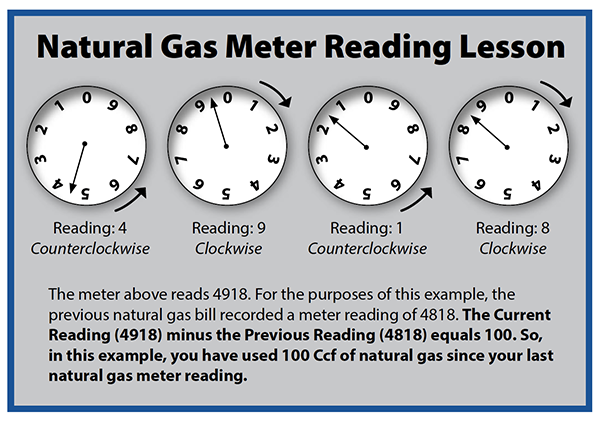Natural Gas Bill Made Easy
 Utility bills are often complex and hard to understand. Often, consumers do not have the time or patience to understand all the charges on the bill. The Office of the Ohio Consumers’ Counsel (OCC) offers this information to help individuals understand their bills better and be more mindful and aware of what is owed to make informed decisions.
Utility bills are often complex and hard to understand. Often, consumers do not have the time or patience to understand all the charges on the bill. The Office of the Ohio Consumers’ Counsel (OCC) offers this information to help individuals understand their bills better and be more mindful and aware of what is owed to make informed decisions.
Establishing Service
To set up utility service, contact the local natural gas company with your service address, personal information, and start date. Your landlord, realtor, or seller should know who provides natural gas service at your new address. If a meter is already on the premises, the utility must start the service within three business days of your request. Ask when you can expect your first bill. The utility has more time to start service if a new meter needs to be installed. Check with the utility company.
Creditworthiness
Before you can establish new service, the utility may need to check your credit to make sure you can pay for it. To establish credit with the utility, you must meet one of the following criteria:
- Be a creditworthy property owner; or
- Have a prior account with a similar type of utility within the past two years, and not have more than two late payments, or been disconnected for non-payment in the last prior service year; or
- Secure a guarantor, who is a customer of the utility, to pay for up to 60 days of service if you fail to pay your bill.
If you do not meet the criteria, you may be required to pay a deposit. That deposit may not exceed an average 30-day bill plus 30 percent. If the utility keeps your deposit for more than six months, it must pay interest on the deposit. After 12 months, the utility will review your account and determine if the deposit should be refunded or credited to the account.
When paying a deposit, the utility should send you a receipt with the following information: name, address, deposit amount, length of time the deposit must be held by the utility to qualify for interest, the interest rate to be paid, and conditions for refunding your deposit.
Usage and meter reading
Natural gas is measured in either hundred cubic feet (Ccf) or thousand cubic feet (Mcf). Your gas utility may obtain an actual meter reading or may estimate how much gas you use each month. Automated meters allow utilities to regularly obtain actual meter readings. If you don’t have one, the company may not always be able to read your meter and can use estimated readings to calculate your usage. An estimated reading uses a formula that considers a few things like the outside temperature and your usage during the same month the previous year. The difference between the estimated and actual usage is adjusted when an actual meter read is obtained.
OCC recommends that you learn how to read your gas meter to make sure you are being charged the right amount. See OCC’s website to learn more.
Natural gas bill structure
Your natural gas bill has two main parts: the delivery cost and the actual cost of the gas you used. The delivery cost covers the services provided by the utility, such as the delivery of gas, installation and repair of pipelines, bill processing, and other functions. It may account for most of your bill. The usage cost, which makes up the remainder of your bill, is passed on by the utility on a dollar-for-dollar basis and includes transportation costs.
Ohio’s gas utilities cannot profit from reselling natural gas. The cost charged to customers cannot be higher than the amount the utility paid purchasing it and is their default rate—also called the standard offer. Most natural gas utilities call their default rate the “Standard Choice Offer” (SCO) or the Gas Cost Recovery (GCR). Some Ohio natural gas customers may choose to get natural gas through an alternative supplier instead. Learn more about Energy Choice with OCC’s How to Make Wise Energy Choices fact sheet at www.occ.ohio.gov/factsheet/wise-energy-choices.
Reading the bill
Natural gas bills may look different depending on the utility company, but they all must provide certain information. This includes the company’s name, address, and phone number, as well as your account number, the service period dates, and your meter readings. Your bill will also show your total charges, any late fees, and your previous balance. It will include information about the cost of the gas you used and a fixed monthly customer charge. Bills also have an area for an explanation of terms or definitions for charges you may not understand.
Additionally, your bill will provide helpful information about energy consumption and how it relates to the charges, as well as contact information for the company and other relevant agencies.
Budget Billing
Ohio’s regulated natural gas utilities offer budget billing plans that allow customers to pay a fixed monthly amount to avoid high bills during heating and cooling seasons.
Each utility has its own unique budget billing plan that lasts up to 12 months. The utility reviews the account periodically and adjusts the budget amount accordingly. Customers are responsible for any remaining balance at the end of the budget period, or they may receive a credit for any overpayment.
To cancel or enroll, contact your utility directly and review the terms and conditions before signing up.
PIPP Plus customers
The Percentage of Income Payment Plan (PIPP Plus) is an extended payment plan to help eligible natural gas (and electric) customers pay their utility bills. Consumers enrolled in PIPP Plus cannot be charged a security deposit to establish service. For more information about PIPP Plus see OCC’s Percentage of Income Payment Plan (PIPP Plus) fact sheet.
Paying the bill
There are different ways to pay your natural gas bill. Some are free, like automatic direct payments and online bill payments. Others cost extra, like using a credit card or electronic check or paying at agent locations.
Remember to allow processing time when you pay your bill. OCC encourages consumers to pay bills well before the due date to avoid disconnection. In addition, the Federal Trade Commission encourages consumers to use a secure browser, read the privacy policy, keep records of their payments, and review their credit card statements if they are paying online.
Natural Gas Utility Sample Bill and Contact Information
How to read your meter
 Gas meters are located either inside the home, usually in the basement utility closet, or outside the home. The gas meter resembles a metal box with pipes extending from it. The meter’s face has four round clock-like dials with digits 0-9 displayed on each one.
Gas meters are located either inside the home, usually in the basement utility closet, or outside the home. The gas meter resembles a metal box with pipes extending from it. The meter’s face has four round clock-like dials with digits 0-9 displayed on each one.
Use the following steps to read your meter:
- Locate the four dials and always remember to read them from left to right. The pointer on the first dial of a gas meter circles counterclockwise, the second dial turns clockwise, the third moves counterclockwise and the fourth travels clockwise.
- Notice the pointer in each dial and write down the number indicated by its position. When the pointer is between two numbers, the reading for the dial is the smaller of the two numbers.
- If the pointer is directly on a number, that number is the reading. When it is difficult to tell if a pointer is directly on a number, look at the dial directly to the right. If the pointer on that dial has not passed zero, record the smaller number of the two.
- To discover how much natural gas has been used since the last meter reading, subtract the actual reading indicated from the last utility bill from the manual reading. After this first reading consumers can track their own natural gas usage and compare them against the monthly bill sent by the utility.
- To monitor natural gas usage on a daily or weekly basis, schedule a time to do a reading then return at the same time the next day or next week to read the meter again. Determine the usage by subtracting the previous reading from the latest reading.
After this first reading you will be able to keep track of your own readings and compare them with your monthly utility bill. Remember that natural gas is measured in either hundreds (Ccf) or thousands (Mcf) of cubic feet.
To download: Click the folder with a down arrow icon. To print: Click the printer icon in the top right of the display.
If you need multiple copies for an organization or group, please contact a member of our outreach team.
